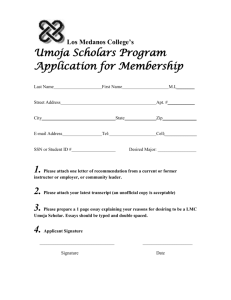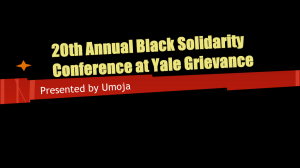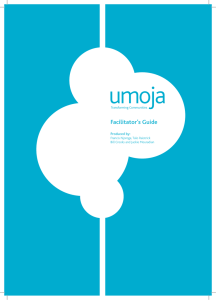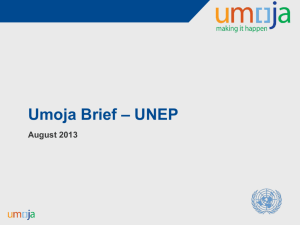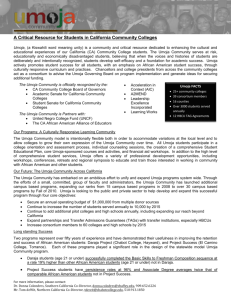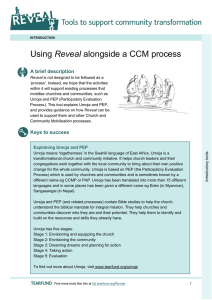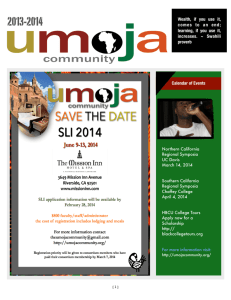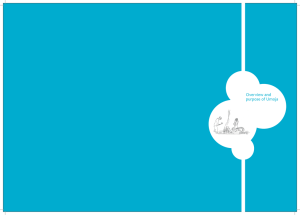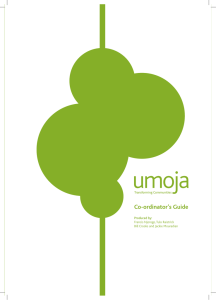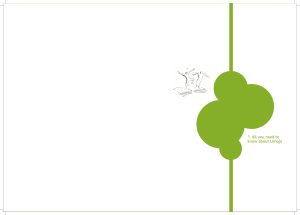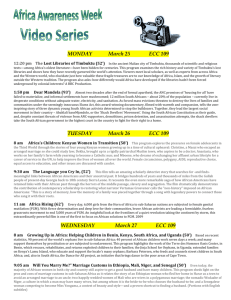Umoja IPC Update, March 2015
advertisement
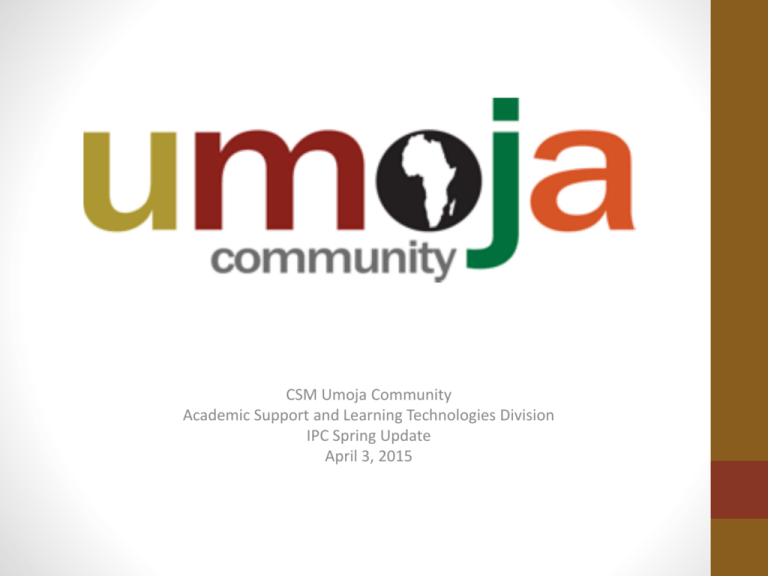
CSM Umoja Community Academic Support and Learning Technologies Division IPC Spring Update April 3, 2015 Curriculum/Program Structure • 2014-15 AY: Linked English and Ethnic Studies (cohort model) • Fall: English 838/Ethnic Studies 105 • Spring: English 105/ Ethnic Studies 288 • Afro-centric curriculum – African and African American history, culture, art, literature, and current events New for the 2015-16 AY Fall 2015 Spring 2016 • Ethnic Studies 105 – all students will enroll in this class with Gaines • Choice of Umoja designated English (828, 838, or 105) with Wallace • CRER 120 with Diaz (not required but highly recommended) • Ethnic Studies 288 – all students will enroll in this class with Gaines • Choice of Umoja designated English (838, 105, or 110) with Wallace • No CRER class but we are interested in creating an IDST leadership course Mentoring Program • Emphasis on the “shared journey” • Mentor is an academic and perhaps even professional resource for mentee • But mentee can also play a vital role in the mentor’s personal and professional growth • All Umoja students have been assigned a mentor based on the selection process (speed dating!) The Indaba Community • Indaba is a Zulu term for “a tribal gathering, consultation, or council meeting” marked by “deep discussions” of matters important to the community. • Unique professional development community that strives to increase faculty’s, staff’s, and administrators’ awareness of the needs of African American students and other students of color. • The Indaba meets approximately 2-3 times a semester. • This spring, the Indaba community has read and discussed Dr. Joy DeGruy’s book Post-traumatic Slave Syndrome. The Umoja Club • Student-centered, student-led • Club is intricately linked to the cohort . . . Club members are a part of the Umoja family • Weekly meetings held in the Village Events and Field Trips • • • • Opening Ceremony De Young Museum Family Tailgate Umoja Statewide Conference • Umoja Regional Symposium • Dr. Joy DeGruy presentation @ Skyline • End-of-the-year celebration The Village Dedicated study/hangout space (opening April 16th) Preliminary Data College-wide • Persistence • Total: 77% • African Americans: 75% • Pacific Islanders: 68% • Course Completion • Total: 70% • African Americans: 58% • Pacific Islanders: 57% CSM Umoja Community • Persistence • Total: 68% • African Americans: 79% • Pacific Islanders: 50% • Course Completion • Total: 69% • African Americans: 71% • Pacific Islanders: 57% Preliminary Data College-wide • Withdrawal • Total: 16% • African Americans: 19% • Pacific Islanders: 20% CSM Umoja Community • Withdrawal • Total: 31% • African Americans: 29% • Pacific Islanders: 43% Why did students leave? • One African American male was so mentally scarred by his experience in special education that he didn’t even come to class on the first day because he saw the handicap placard on the door. He thought it was a class for disabled students. • One African American female left because her cousin was shot and her uncle was raided by the SWAT team (both happened within weeks). • A Hispanic couple joined Umoja together but broke up about halfway through the semester. Both eventually dropped because of the circumstances surrounding the breakup. Why did students leave? • One Polynesian male had to withdraw because the only job he could find was on the graveyard shift (his shift ended just hours before class started). • One African American male was homeless for the first two months of class. He was living in a motel room with three other students until they could afford a deposit for an apartment. This particular student was also shot while home in Sacramento. He persisted through the fall semester, passed on an incomplete, and is still attending CSM. • One Polynesian female was pregnant and had to withdraw to prepare for the birth of her child. Similarly, one African American female had a baby at home who often pulled her from her homework and from attending class. CSM Umoja Three-year Plan 2014-15 AY 1. Develop an Afro-centric curriculum 2. Develop mentoring program 3. Build the Indaba Community 2015-16 AY 1. Expand recruitment and outreach 2. Support acceleration efforts 3. Develop strategies to increase student success 2016-17 AY 1. Develop Umoja student leadership course 2. Expand Indaba Community 3. Develop peer mentoring program 2014-15 AY Develop Afro-centric curriculum • At the core of the Umoja Community is a curriculum that reflects the identity of the target population. The curriculum highlights African and African American culture, history, literature, and current events. Develop mentoring program • The Umoja mentoring program pairs Umoja students with CSM faculty, staff, and administrators and emphasizes the shared journey of both the mentor and the mentee. Build the Indaba Community • Indaba, a Zulu term for a “tribal gathering” to discuss issues important to the community, is a unique professional development program that seeks to identify the most culturally sensitive faculty, staff, and administrators and to facilitate a “deep discussion” about the obstacles students of color face at CSM. 2015-16 AY Expand recruitment and outreach • We want to connect with the local high school BSU’s to create a pathway between local schools and the CSM Umoja Community. This goal also includes substantial in-reach and coordination with learning communities like Project Change and Pathway to College. Support acceleration efforts • As a means to increase access to the Umoja Community, we are interested in supporting and piloting an English acceleration model in coordination with BSI and the California Acceleration Project team. Develop strategies to increase student success • We want to “fine tune” the Umoja curriculum and Indaba professional development program using current research and strategies on working with African American students (and other at-risk students). These strategies will also include “student success teams” that promote regular student contact with the Umoja counselor, peer tutors, instructors, and mentor. 2016-17 AY Develop Umoja student leadership course • As a sort of “capstone” to the Umoja program, the student leadership course will offer students an opportunity to use the knowledge and skills they have learned in the broader community. Expand Indaba Community • As the Indaba grows, it will evolve into a network of culturally relevant faculty that will create a loosely organized first year experience for incoming Umoja students. Develop peer mentoring program • In addition to the current mentoring program, we would like to add a peer mentoring component as part of the “student success teams” in an effort to increase student success, persistence, and retention.
